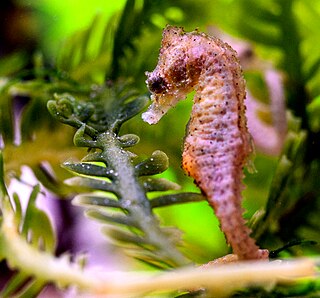Related Research Articles

Zostera is a small genus of widely distributed seagrasses, commonly called marine eelgrass, or simply seagrass or eelgrass, and also known as seaweed by some fishermen and recreational boaters including yachtsmen. The genus Zostera contains 15 species

Zosteraceae is a family of marine perennial flowering plants found in temperate and subtropical coastal waters, with the highest diversity located around Korea and Japan. Most seagrasses complete their entire life cycle under water, having filamentous pollen especially adapted to dispersion in an aquatic environment and ribbon-like leaves that lack stomata. Seagrasses are herbaceous and have prominent creeping rhizomes. A distinctive characteristic of the family is the presence of characteristic retinacules, which are present in all species except members of Zostera subgenus Zostera.

Wrack is part of the common names of several species of seaweed in the family Fucaceae. It may also refer more generally to any seaweeds or seagrasses that wash up on beaches and may accumulate in the wrack zone.

The dwarf seahorse is a species of seahorse found in the subtidal aquatic beds of the Bahamas and parts of the United States. It is threatened by habitat loss. According to Guinness World Records, it is the slowest-moving fish, with a top speed of about 5 feet (1.5 m) per hour.

Sagenista is a group of heterokonts containing the labyrinthulids and Eogyrea, a class of yet uncultured protists. Originally, it contained the Labyrinthulids and bicosoecids. However at present the bicosoecids have been removed, and Eogyrea were added, in order to make the group monophyletic.
Whitecliff Bay and Bembridge Ledges is a 131.6-hectare (325-acre) Site of Special Scientific Interest that lies around the coastline of the easternmost part of the Isle of Wight from the Bembridge harbour entrance in the north around Foreland to Whitecliff Bay to the south. The site was notified in 1955 for both its biological and geological features.
The genus Labyrinthula is part of the protist group Labyrinthulomycetes and contains thirteen species. The major feature of this genus is the formation of an ectoplasmic net secreted by specialized organelles called bothrosomes which surrounds the colony, which is also used by Labyrinthula for moving. The protist reproduces by zoosporulation as it sets some flagellated spores free from a sporangium. Zoospores prove the belonging of Labyrinthula in the Heterokont phylum due to the distinct flagellar morphology, in which the anterior one is covered in mastigonemes.

Zostera marina is a flowering vascular plant species as one of many kinds of seagrass, with this species known primarily by the English name of eelgrass with seawrack much less used, and refers to the plant after breaking loose from the submerged wetland soil, and drifting free with ocean current and waves to a coast seashore. It is a saline soft-sediment submerged plant native to marine environments on the coastlines of northern latitudes from subtropical to subpolar regions of North America and Eurasia.

Psammechinus miliaris is a species of sea urchin in the family Parechinidae. It is sometimes known as the green sea urchin or shore sea urchin. It is found in shallow areas of the eastern Atlantic Ocean and the North Sea.

Zostera noltii is a species of seagrass known by the common name dwarf eelgrass. It is found in shallow coastal waters in north western Europe, the Mediterranean Sea, Black Sea, Caspian Sea and Aral Sea and on islands in the Atlantic off the coast of northwest Africa. It is an important part of the intertidal and shallow subtidal ecosystems of estuaries, bays and lagoons.
Dokdonia is a genus of bacteria in the family Flavobacteriaceae and phylum Bacteroidota.
Apiogalacturonans are a type of pectins known to be found in the walls of Lemna and Zostera marina. Substituted galacturonans are characterized by the presence of the saccharide appendant residue D-apiose in the case of apiogalacturonan, branching from a backbone of D-galacturonic acid residues. According to the Complex Carbohydrate Research Center, "[t]he backbone of these polysaccharides is resistant to fragmentation by microbial EPGs."
Kordia algicida is an algicidal, Gram-negative, strictly aerobic and non-motile bacterium from the genus Kordia which has been isolated from sea water from the Masan Bay in Korea.
Kordia antarctica is a Gram-negative, chemoheterotrophic, facultatively anaerobic and non-motile bacterium from the genus Kordia which has been isolated from seawater from the Antarctic.
Kordia aquimaris is a Gram-negative, strictly aerobic, non-spore-forming and non-motile bacterium from the genus Kordia which has been isolated from seawater from the coast near the Taichung harbour in Taiwan. Kordia aquimaris produces zeaxanthin.
Kordia jejudonensis is a Gram-negative, aerobic, non-spore-forming and rod-shaped bacterium from the genus Kordia.
Kordia periserrulae is a Gram-negative, chemoheterotrophic and facultatively anaerobic bacterium from the genus of Kordia which has been isolated from the worm Periserrula leucophryna from the Yellow Sea in Korea.
Kordia ulvae is a Gram-negative, aerobic and rod-shaped bacterium from the genus Kordia which has been isolated from the alga Ulva.
Kordia zhangzhouensis is a Gram-negative, aerobic, rod-shaped and non-motile bacterium from the genus Kordia which has been isolated from surface freshwater from the Jiulong River in China.
Olleya sediminilitoris is a Gram-negative bacterium from the genus of Olleya which has been isolated from tidal flat sediments from the Yellow Sea.
References
- 1 2 "Species: Kordia zosterae". LPSN.DSMZ.de.
- 1 2 Kim, Dae In; Lee, Ji Hee; Kim, Mi Sun; Seong, Chi Nam (1 November 2017). "Kordia zosterae sp. nov., isolated from the seaweed, Zostera marina". International Journal of Systematic and Evolutionary Microbiology. 67 (11): 4790–4795. doi: 10.1099/ijsem.0.002379 . PMID 28984217.
- ↑ "www.uniprot.org".
{{cite journal}}: Cite journal requires|journal=(help)